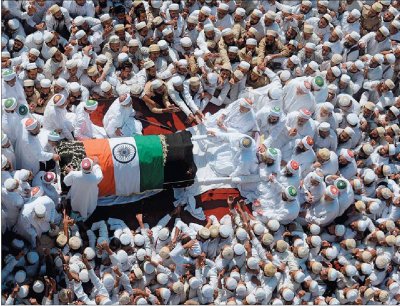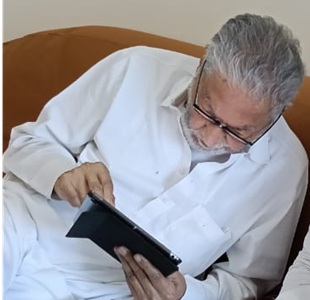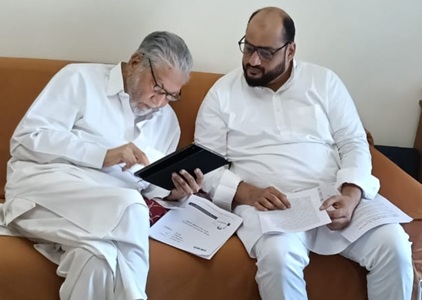By Aliasger al-Anwar,
Research Assistant, Al-Jamea tus-Saifiah
There is something about the enormity and vastness of the sea that is difficult to put to words if not difficult to comprehend. In its swelling and heaving, it flows and moves as if it were a single
entity, yet it comprises of innumerable little droplets that come together from the far corners of
the earth. This was the sight that met Mumbaikars on the morning of the 18th of January. A sea
of followers of His Holiness Dr Syedna Mohammed Burhanuddin flowed onto the streets of South
Mumbai. Amidst this sea of sober white, like a precious vessel in a mighty ocean of devotion and love, was the vehicle carrying the janazah (bier) of a beloved father and departed leader.
At first, like the sight of the ocean, its expansive oneness is striking, aweinspiring. Yet upon
careful observation of the mass that made its way from Malabar Hill to Bhendi Bazaar, the
individuals in the vast whiteness, the separate elements could be made out. A small boy on the
shoulders of his father; his hands clasped together calling out with shouts of ‘Moula, Moula’. A
young man striving, struggling against the tides of his fellow mourners, to draw himself a few
inches closer to the janazah so as to bid a final farewell to a spiritual father whose tenderness
and care is all he has ever known and whose guidance gave him strength during the most
difficult times of his life. An elderly gentleman who from afar, squinting because of the tears in his
eyes and the sun on his brow, yearns to catch the final glimpses of the wise and visionary man
whose direction led him unscathed through a World War, the Partition and many other
calamities, and whose name he just taught his great grandchild the other day. In this ocean of
followers and believers, there are individuals: individuals who have each been touched and
blessed by the presence of Syedna Burhanuddin in their lives.
And this is what was most remarkable about His Holiness, the 52nd Dai and head of the
Dawoodi Bohra Muslim community. Over the last fifty years at the helm of the community, he
brought the Bohras together like no other time in their history. He helped crystallize their identities
as modern, peaceloving, educated, and devoted Muslims who are loyal citizens to the countries
they reside in no matter what part of the world that may be. Alongside this achievement of
solidarity and unity, His Holiness somehow also managed to inspire and touch the lives of each
and every member of the Bohra community at an individual and personal level.
In postcolonial South Asia, where authorities had spent decades categorizing along cultural,
religious, linguistic and social identities, people had been divided; their sense of community
mutated and altered. At such a time, His Holiness Dr Syedna Mohammed Burhanuddin
endeavoured to bring his followers together. Throughout his tenure as alDai alMutlaq, Syedna
performed the function of the ultimate summoner, one of the meanings of the Arabic name for
the office that he was the incumbent of. At various key points over the last five decades, His
Holiness assembled the community and brought them together for events that would transform
the Dawoodi Bohras forever, allowing them to reach heights of spiritual and temporal prosperitynever known before.
In 1979, His Holiness organised a series of gatherings in the city of Surat, his ancestral home
and the seat of the historic Dawoodi Bohra Arabic Academy, AljameatusSaifiyah. The event
was known as alMultaqa alIlmi alFatemi, or the Fatemi Philosophical Assembly. Thousands of
community members from across India and other parts of the world converged on this city in the
state of Gujarat heeding His Holiness’ call. There, His Holiness would set the scene for the next
chapter of the community’s collective history and prepare them for the transition from the 20th to
21st century. During the Multaqa, His Holiness held sessions to discuss various aspects of the
Islamic faith, specifically those that were at jeopardy at the hands of notions of modernity and
progress. The result of this event was the creation of a unique paradoxical personality for the
Dawoodi Bohra community that has remained its identity ever since: a sense of tradition and
orthodoxy coupled with a conscientious embracement of modernity and progress.
Among the bustling markets of Old Cairo, hidden behind the old Fatimid walls lies another
example of Syedna Burhanuddin’s ability to transform and assemble. After centuries of neglect
and dilapidation, the 11th century alJaame’ alAnwar, also known as the Masjid of Imam
alHakim bi Amrillah was restored by His Holiness and inaugurated in 1981 by President Anwar
Sadat. This event, soon after the gatherings of the heralded Multaqa, saw ten thousand Dawoodi
Bohras gather in the great masjid of alAnwar: a gathering in Cairo that was unprecedented in
the annals of Bohra history . The restoration would mark the beginning of a period of unparalleled
prosperity for the community. All throughout the world, places of worship were constructed,
centres for learning were established, and businesses and homes were formed and built.
The ultimate embodiment of Syedna Burhanuddin’s capacity to bring together, however, is the
annual Asharah event that takes place for the commemoration of the martyrdom of the Prophet
Mohammed’s grandson, Imam Husain. At the onset of every Islamic year, His Holiness would
choose a venue for the nine day event that comprised of ten sermons on topics ranging from
Islamic history and philosophy to guidance and counsel regarding getting married, starting a
business and taking care of one’s parents. Community members would flock to the annual
gatherings, even if only for the last few days. The Asharah event allowed the opportunity for 1400
year old Islamic teachings and principles to be contextualized for life in the modern age.
Though His Holiness often called his followers to him, he too, travelled to them. Syedna
Burhanuddin during the fifty years of his tenure has travelled the world like none of his
predecessors. From ancient community establishments in the remote villages of India and the
mountains of Yemen to newly founded fledgling community centers in the sprawling
metropolises of the West, Syedna travelled far and wide, by train and by plane, by road and by
sea. His tireless travels and many sleepless nights ensured that his community despite being
separated by thousands of miles and burdened by barriers of culture and language remained
united. Throughout his travels, Syedna encouraged his followers to embrace the countries they
lived in, encouraging them not only take pride in their Islamic heritage, but the citizenship of the
countries that they now called home. The Star of Jordan, the Order of the Nile and numerousother government and heads of state accolades as well as official proclamations in the senates
and parliaments of various states and nations all give testimony to His Holiness’ ability to leave a
profound impact on people wherever he went.
Knowledge and learning lie at the foundation of any society. His Holiness had dedicated huge
resources to establishing schools and colleges in various cities across India and other parts of
the world. Alongside secular education, Syedna Burhanuddin recognized the need for religious
education and understanding in a world where religion has been misused by the misguided.
Secular education coupled with a sound understanding of the tenets of faith is essential for
today’s world. It enables individuals to contribute to the progress of society while holding
steadfast to their beliefs and not falling victim to extreme understandings propagated by those
who would use religion towards their own selfish ends. In his lifetime, His Holiness added three
additional campuses to the historic seminary and Arabic academy, AljameatusSaifiyah. With
campuses now in South Asia and East Africa, and extension programs dedicated to fostering
better understanding of the Quran in the Middle East and the US, His Holiness has proven that
there is dire need for traditional education in today’s world and that secular and religious
education compliment one another when pursued for the good of mankind.
His Holiness was a visionary and innovator. His establishment of an expansive network of
interestfree Qardan Hasanaa (Islamic loans) ranging from micro financing to large scale
corporate level lending has enabled the Bohra community to prosper in economic terms while
remaining safeguarded from the volatility and irregularity of interestbased financial tools. Fayd
alMawaaid alBurhaniyah, a community kitchen initiative instituted by His Holiness and
implemented with the guidance of his son and successor Syedna Mufaddal Saifuddin TUS
has helped thousands of households. Through this effort, the homes of both the fortunate and less
fortunate are provided identical nutritious meals from a community kitchen. This new found
freedom for homemakers allows them to invest their time in other pursuits that can help them
tend to their family and generate greater income. With initiatives like these, His Holiness has
worked hard to bring the Bohra community to one table, literally.
Though the Dawoodi Bohra community has benefitted greatly from His Holiness’ leadership, they
are not the only ones. Syedna Burhanuddin has touched the lives of thousands of ordinary
people here in South Asia and abroad. His various philanthropic initiatives have helped different
stratas of society by providing equal opportunities for health, education and living conditions. The
notforprofit Saifee Hospital, housed in an iconic building overlooking the Queen’s Necklace in
South Mumbai, offers worldclass healthcare at affordable costs. Various schools and colleges
across South Asia, the Middle East and East Africa owe their existence to His Holiness.
Thousands of students have benefitted from these establishments and other educational
endowments managed by Syedna. His Holiness’ most ambitious philanthropic enterprise has
been the SBUT (Saifee Burhani Upliftment Trust) project which aims to rehabilitate hundreds of
families living in poor conditions. The redevelopment of such a large urban expanse in one of the
most crowded, unsanitary and dilapidated areas of Mumbai has not been attempted in this way
with these restrictions anywhere in the world.For fifty years His Holiness has toiled for the betterment and prosperity of his community and the
society at large. So today, as he is laid to rest besides his father in the mausoleum he built for
him half a century ago, the contributions and sacrifices he has made for the betterment of the
large expanse of people garbed in their sober white robes on the streets surrounding the
mausoleum are abundantly clear. And that is why they have come. They have come to bid
farewell, and despite these many endeavors, projects and achievements, each man, woman
and child today can only think of that moment when His Holiness changed their lives.
His Holiness Syedna Mufaddal Saifuddin TUS, Syedna Burhanuddin’s successor and the 53rd Dai
very eloquently describes his father’s funeral procession in a verse from his eulogy as follows,
“And when we carried his janazah [towards the mausoleum] it was as if it was a vessel which
provided deliverance to the souls of each who answered its call”. For different people, this
deliverance meant different things. For the young boy, it was when His Holiness, a man whose
awe left him speechless, looked at him and asked him his name. For the mother of two, it was
when he offered a prayer for the health of her then chronically ill child, now cured. For the naive,
inexperienced, newly married gentleman, it was His Holiness’ kind words of assurance that Allah
will provide for him and his family. For the two month old little infant, who now does not even
know it, it was the moment Syedna softly touched his cheeks which he will only be able to recall
from the photographs his parents show him of that day. Regardless of their perceived triviality or
insignificance, interactions with a man of such stature, generosity and kindness leave a lasting
impression.
Great leaders are those who have the uncanny ability of bringing people together; even greater
are those who can inspire them each at a personal level, speak to them and motivate them to be
better people. His Holiness did both. So today, as the sea of sober white slowly ebbs and fades
into the distance, we look back at his life, and our own, and we remember the ways he made us
feel part of a community, the way that he gave us identity. Yet we also reflect fondly upon those
fleeting instances where he made us feel special, when he let us know we were unique, as if we
were the only droplet of water in the great big ocean.






0 Comments